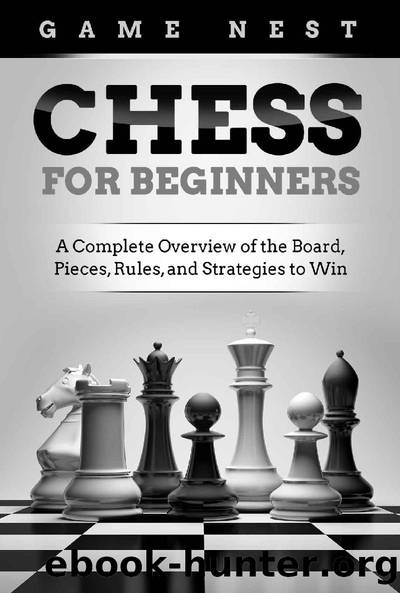Chess for Beginners: A Complete Overview of the Board, Pieces, Rules, and Strategies to Win by Game Nest

Author:Game Nest [Nest, Game]
Language: eng
Format: epub
Published: 2020-05-10T00:00:00+00:00
Figure 24: In this early middlegame scenario, each player has castled their king, but otherwise, their strategies are different.
In the figure above, both players have gone to great lengths to secure the king. White has opted forâor been forced intoâan extremely defensive formation. While this can provide an effective wall, White runs the risk of being boxed in. Black has taken a more aggressive approach, potentially gaining an advantage if they can maintain the initiative.
Securing Advantages
Assuming your king isnât under threat, the goal of the middlegame is to gain as many endgame advantages as possible. This is done through two primary means, each of which is an intrinsic part of chess strategy: material and board position.
Different masters have differing opinions on which of these is more valuable. Materialists are often more tactical players who value the power and options each piece provides. Positional players tend towards a more detached, strategic outlook, and will sacrifice even valuable material in order to force their opponent into a bad spot. Discovering which type of player you are and why is an important step in finding a comfortable middlegame mindset.
Securing a material advantage means going into the endgame with more materialâor a higher overall piece valueâthan your opponent. This is often done through clever gambits, laying traps for the opponent to create scenarios where theyâre forced to choose which piece to sacrifice. Material gains can be slow to start, but capturing an opponentâs queen or rook in the middlegame can speed you to an advantageous endgame.
Positional play is less concerned with targeting individual pieces an opponent controls. Rather, creating an overall favorable spread on the board is this strategyâs key to victory. After all, if an opponentâs most dangerous pieces can be effectively locked down by your formation, why risk breaking it to capture them? Thatâs not to say positional players are more risk-averse. Many will sacrifice a material advantage for the chance to blow a hole through the enemyâs guard.
For beginning players, either option is viable, though both extremes should be avoided. The consequences of all-out materialism or positional play can be offset by some masters, but even then, most strive for a balance that leans towards their preferred method.
In either case, learning to make favorable exchanges is perhaps the most important skill to develop and strengthen your middlegame. In formal terms, an exchange refers to the trading of two pieces, but there are positional exchanges to consider as well. Will you abandon your stranglehold on the center of the board to capture an enemy rook? Your answer may well depend on several other factors in the game, and learning to weigh those factors is what makes for great play in the middlegame.
Download
This site does not store any files on its server. We only index and link to content provided by other sites. Please contact the content providers to delete copyright contents if any and email us, we'll remove relevant links or contents immediately.
The Infinite Retina by Robert Scoble Irena Cronin(6078)
Harry Potter and the Cursed Child: The Journey by Harry Potter Theatrical Productions(4430)
The Sports Rules Book by Human Kinetics(4272)
Molly's Game: From Hollywood's Elite to Wall Street's Billionaire Boys Club, My High-Stakes Adventure in the World of Underground Poker by Molly Bloom(3473)
A Knight of the Seven Kingdoms by George R R Martin(3175)
Quidditch Through the Ages by J.K. Rowling(3053)
How To by Randall Munroe(3016)
Flowers For Algernon by Daniel Keyes(2938)
Quidditch Through the Ages by J K Rowling & Kennilworthy Whisp(2921)
Quidditch Through the Ages by Kennilworthy Whisp by J.K. Rowling(2807)
Stacked Decks by The Rotenberg Collection(2796)
Quidditch through the Ages by J. K. Rowling(2759)
Quidditch Through The Ages by J. K. Rowling(2721)
776 Stupidest Things Ever Said by Ross Petras(2678)
Ready Player One: A Novel by Ernest Cline(2637)
What If?: Serious Scientific Answers to Absurd Hypothetical Questions by Randall Munroe(2626)
Beautiful Oblivion by Jamie McGuire(2557)
The Book of Questions: Revised and Updated by Gregory Stock Ph.d(2502)
Champions of Illusion by Susana Martinez-Conde & Stephen Macknik(2403)
